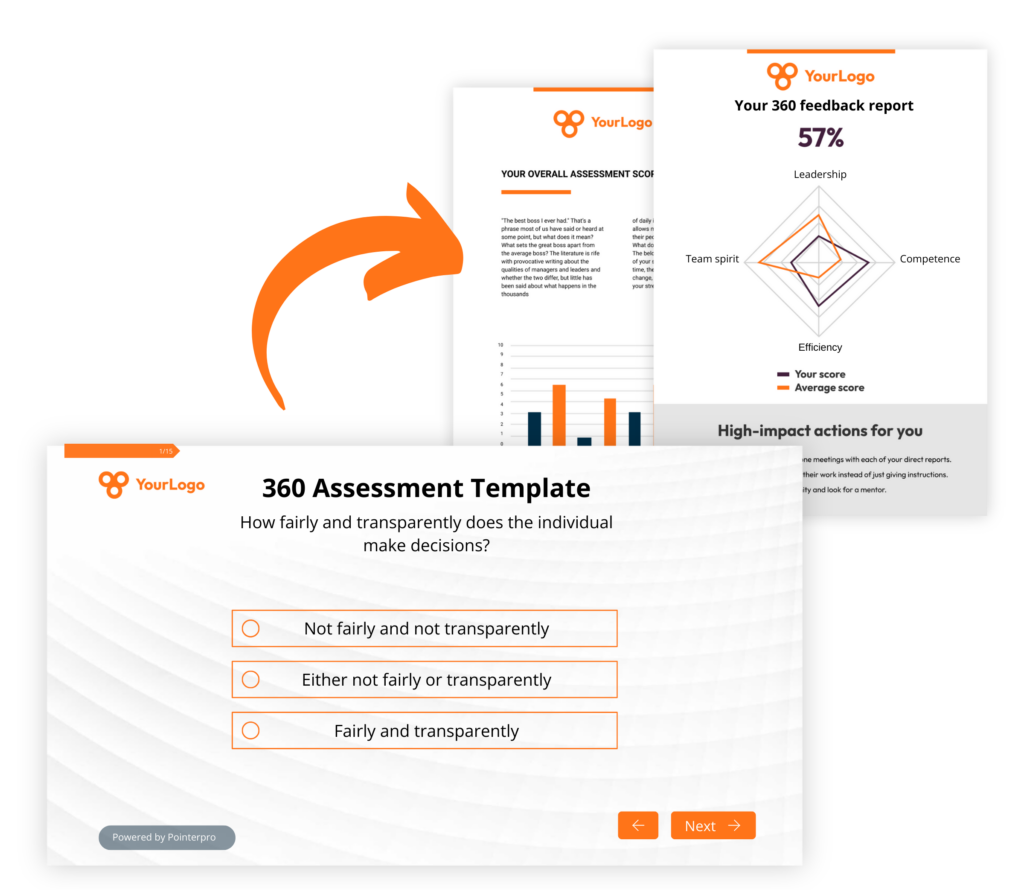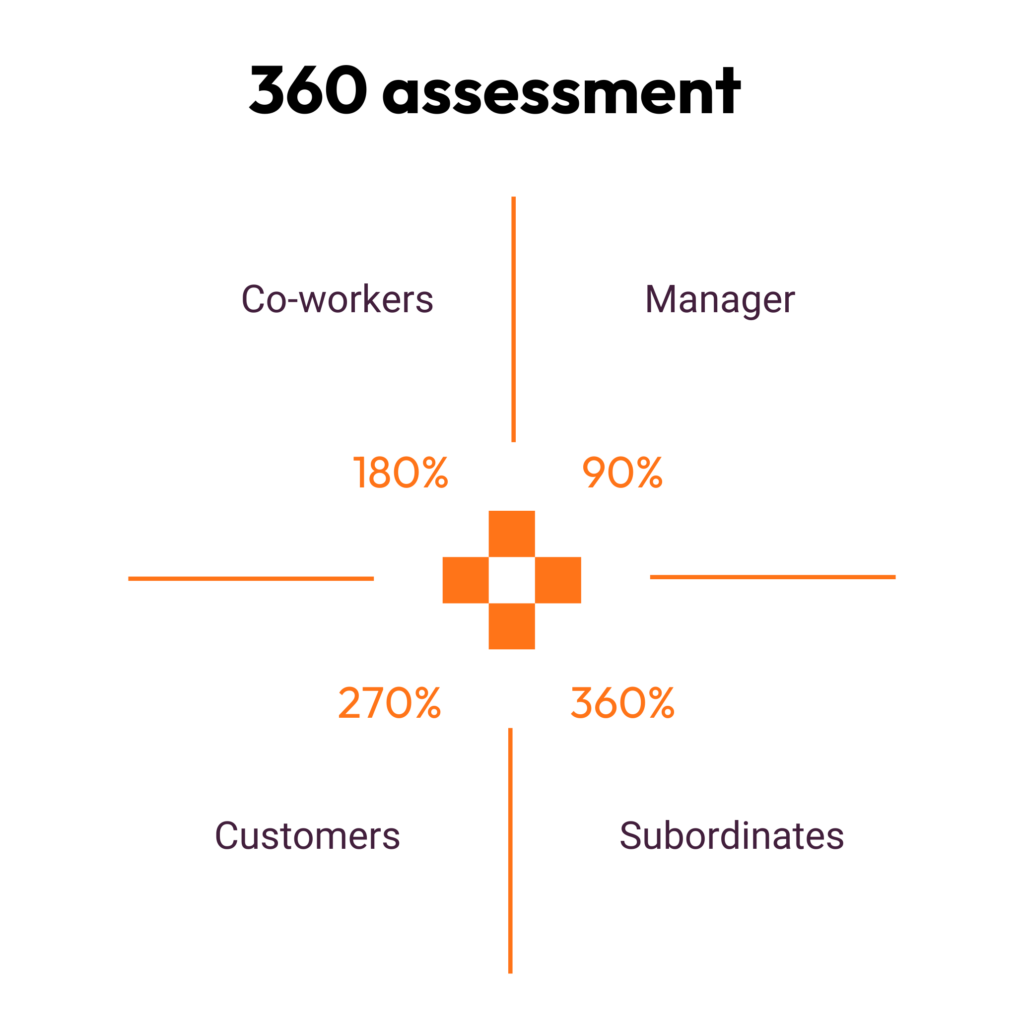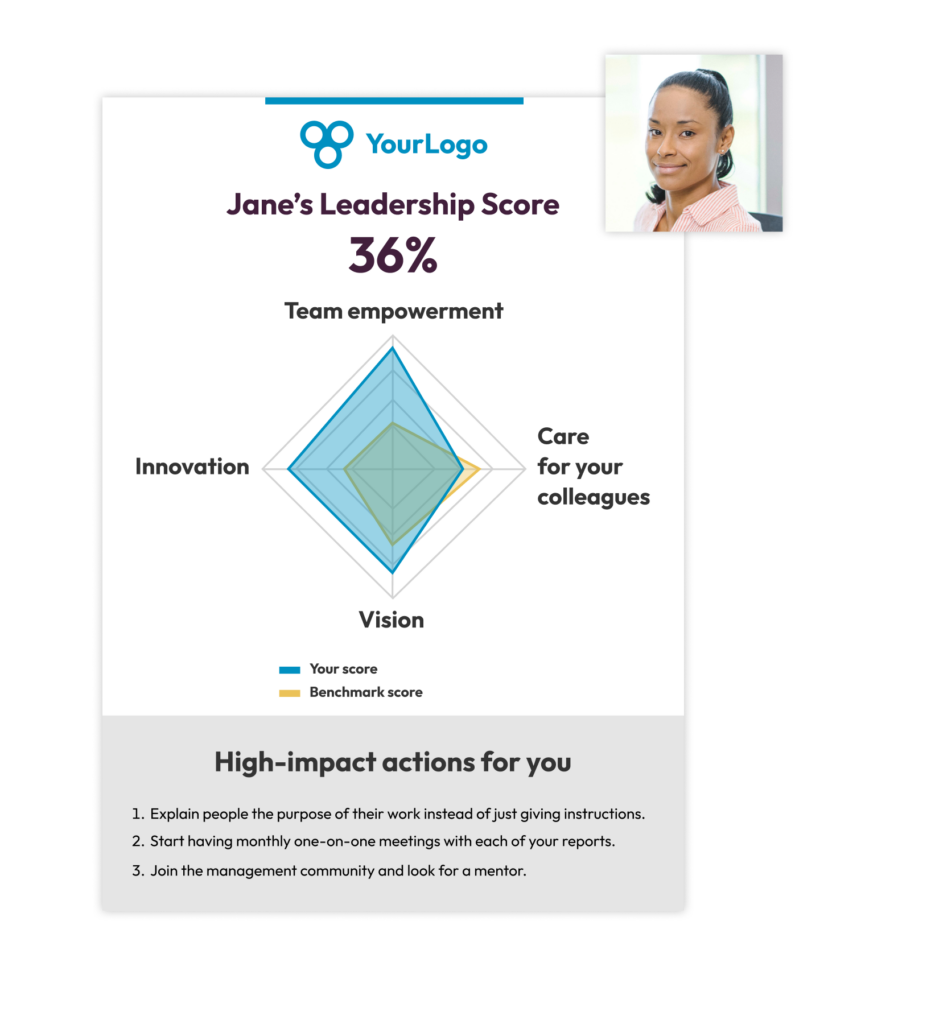360 assessment template
Are you looking for a way to evaluate people in your organization more accurately? Then set up a 360-degree feedback system.
Such a system starts with a solid 360 assessment template.
Pointerpro is the 2-in-1 software that combines assessment building with personalized PDF feedback report generation.

What is a 360 assessment?
In any professional context, feedback is the oxygen that breathes life into an employee’s personal development and overall success. However, if the wind blows too hard from only one direction – that of the manager – blind spots are overlooked, and progress tends to fade.
That’s what makes a 360 feedback system so vital. To make such a system as smooth as can be, you need a solid 360 assessment: One or more objective questionnaires that allow different people who work with your employee to evaluate different aspects of his or her work.
Some 360 assessment templates focus on particular domains of someone’s work. Common themes are leadership assessments or communication skills assessments. Every 360 assessment brings value to the table. The crucial points? On one hand, assessment models that allow you to quantify feedback, in order to benchmark results against expected standards. On the other hand, you need a way to translate assessment scores into personalized and actionable feedback.
3 reasons to use Pointerpro as a 360 assessment tool
Interactive user experience
With the Questionnaire Builder, you get to create an engaging feedback form. How? With numerous design and layout options, useful widgets, and countless question types.
Refined, score-based analysis
Our custom scoring engine helps you quantify and categorize diverse answers. The result? An objective and nuanced 360 assessment that helps your employees forward.
Automated feedback in PDF
Thanks to your setup in the Report Builder, and its Aggregate Reports feature, employees get a detailed PDF report: with personalized feedback, useful tips, and an action plan.
1.500+ businesses worldwide build assessments with Pointerpro









The 360 assessment template vs the traditional performance review
So what exactly is meant by 360 degrees? In the context of a typical employee review, you want to make the perspective of the evaluation as wide as possible. A traditional performance review restrains itself to a single point of view, that of the manager. The reality of employee performance is that different stakeholders are affected by it (or the lack of it).
For example:
- Maybe your employee is struggling to report well to her or his manager, lowering the scores that the manager in question would attribute to the employee.
- At the same time, coworkers may be delighted working with the employee on a daily basis.
- External stakeholders - like customers - may be happy about your employee’s efforts too, but at the same time, have some remarks similar to the ones of the manager, regarding the clarity of communication.
- People who, on the other hand again, report to the employee may have other positive pieces of feedback to weigh in on the evaluation.
A traditional performance evaluation would be restrained to the first bullet point. A 360 assessment provides much more nuance and results in a more objective evaluation overall.

How to set up and write a 360 assessment?
A 360 assessment provides a well-rounded view of strengths, weaknesses, and areas for development. Take the following guidelines into account when setting up your 360 feedback system:
- Clearly identify and define the purpose and goals of the assessment, such as leadership development or performance improvement.
- Select relevant competencies or behaviors to assess, aligning them with organizational values and objectives.
- Choose appropriate raters who have regular interactions with the individual being assessed, ensuring diverse perspectives.
- Design clear and concise rating scales or questions to evaluate each competency, allowing for both quantitative and qualitative feedback.
- Ensure anonymity and confidentiality to encourage honest and candid feedback from participants.
- Provide opportunities for feedback interpretation and action planning, supporting the individual in understanding and acting upon the results for personal and professional growth.
Effective 360 assessment template questions
It’s important not to underestimate the effect your questions can have on the respondents in a 360 assessment. Here are some tips that should help you write your 360 assessment questionnaire:
- Be specific: Ensure that questions are specific and clearly defined to address particular competencies or behaviors relevant to the individual's role or objectives.
- Use behavior-based questions: Frame questions around observable behaviors rather than subjective traits. This makes it easier for raters to provide concrete and actionable feedback.
- Balance positivity and constructive criticism: Include questions that solicit feedback on both strengths and areas for improvement, maintaining a balanced perspective.
- Combine closed-ended questions with clarification prompts: Use closed-ended questions (for instance, with rating scales) to gather quantitative data and make the evaluation as objective as possible. Also, incorporate the possibility to add some nuanced feedback, associated with these questions. Some open-ended questions can be valuable too.
- Provide context: Offer context for each question to help raters understand the purpose and relevance of the feedback they are providing.
- Avoid leading questions: Ensure that questions are neutral and unbiased, avoiding language that may influence respondents' perceptions or responses.
- Pilot test questions: Before finalizing the questionnaire, pilot test the questions with a small group to identify any ambiguities or issues and refine them accordingly.
- Keep it manageable: Limit the number of questions to a manageable amount to prevent survey fatigue and ensure higher completion rates.
360 assessment example questions
Here are 30 example questions for 360 review assessments divided into 3 categories
- 10 360 leadership assessment example questions
- 10 360 sales competency assessment example questions
- 10 360 problem-solving assessment example questions
10x 360 leadership assessment example questions
The following 360 assessment template questions are designed to assess various leadership competencies and behaviors using a closed-ended format, allowing raters to select response options that best reflect their perceptions of the individual being assessed.
Each question is focused on specific aspects of leadership, such as communication, decision-making, and relationship-building.
- How effectively does the individual communicate organizational goals and expectations to their team?
- To what extent does the individual demonstrate empathy and understanding towards team members' concerns and challenges?
- How consistently does the individual provide constructive feedback and recognition to their team members?
- How well does the individual facilitate collaboration and teamwork within their team or department?
- To what degree does the individual demonstrate resilience and adaptability in the face of challenges or setbacks?
- How does the individual delegate tasks and responsibilities to team members based on their strengths and capabilities?
- How clearly does the individual articulate a vision for the future and inspire others to work towards common goals?
- How fairly and transparently does the individual make decisions that affect their team or department?
- How successfully does the individual manage conflict and resolve interpersonal issues within their team?
- How actively does the individual seek feedback and opportunities for self-improvement to enhance their leadership effectiveness?
10x 360 sales competency assessment example questions
- How effectively does the individual identify and qualify potential leads or prospects?
- To what extent does the individual demonstrate active listening skills during sales interactions with customers?
- How consistently does the individual tailor their sales approach to meet the unique needs and preferences of each customer?
- How well does the individual handle objections and address concerns raised by customers during the sales process?
- To what degree does the individual follow up with leads and prospects in a timely and persistent manner?
- How successfully does the individual negotiate and close deals to meet or exceed sales targets?
- How clearly does the individual communicate product features, benefits, and value propositions to customers?
- How effectively does the individual build and maintain long-term relationships with customers to foster repeat business and referrals?
- How efficiently does the individual manage their sales pipeline and prioritize activities to maximize sales opportunities?
- How actively does the individual seek feedback and seek opportunities for skill development to enhance their sales performance?
These 360 assessment template questions aim to evaluate various sales competencies crucial for success in a sales role.
Each question is structured as a closed-ended item, allowing raters to choose response options that align with their view of the individual’s performance in specific areas such as prospecting, communication, and customer relationship management.
10x 360 problem-solving assessment example questions
- How effectively does the individual identify and define the root causes of complex problems?
- To what extent does the individual generate creative and innovative solutions to address challenging issues?
- How consistently does the individual evaluate potential solutions based on their feasibility and potential impact?
- How well does the individual prioritize tasks and allocate resources to resolve problems in a timely manner?
- To what degree does the individual anticipate and mitigate potential risks associated with proposed solutions?
- How successfully does the individual collaborate with others to gather diverse perspectives and insights when solving problems?
- How clearly does the individual communicate their problem-solving approach and rationale to stakeholders?
- How effectively does the individual adapt their problem-solving strategies in response to changing circumstances or new information?
- How efficiently does the individual implement and monitor solutions to ensure desired outcomes are achieved?
- How actively does the individual reflect on past problem-solving experiences and seek opportunities for learning and improvement?
These 360 assessment template questions are designed to assess an individual’s problem-solving skills across various contexts and situations. Each question is designed to accurately reflect respondents’ perceptions of the individual’s ability to analyze problems, generate solutions, and make effective decisions.
What Pointerpro clients are saying




360 assessment report: Best practices
Overall, a well-structured and thoughtfully designed 360 feedback report will enhance the effectiveness of the assessment process and support the individual’s growth and development efforts.
Here are some best practices for structuring and designing a 360 feedback report:
- Cover page: Include a professional and visually appealing cover page with the individual's name, position, and the date of the assessment. Include the organization's logo or branding elements for consistency.
- Introduction: Provide a brief introduction to the purpose and process of the 360 assessment. Explain the significance of feedback and its role in professional development.
- Overview section:Offer a high-level summary of the individual's overall strengths and areas for development. Include key statistics or metrics, such as average ratings or percentile rankings, to provide context.
- Feedback sections: Organize feedback into sections based on the competencies or areas assessed (e.g., leadership, communication, problem-solving). For each competency, provide a summary of feedback received from raters, highlighting key themes or trends. Include both quantitative data (e.g., average ratings) and qualitative comments to provide a comprehensive view.
- Visual elements: Use visual aids such as charts, graphs, or infographics to illustrate feedback trends or comparisons between raters. Incorporate color coding or icons to differentiate between positive and development areas.
- Action plan: Provide guidance on the next steps for the individual, including specific development goals and strategies. Include suggestions for resources or support available for achieving these goals.
- Conclusion: Summarize key takeaways from the feedback report and reiterate the importance of ongoing development. Encourage the individual to reflect on their feedback and actively engage in the development process.
- Appendices: Include any additional supporting materials or documentation, such as the survey instrument used, rater instructions, or glossary of terms.
- Formatting and design: Ensure readability by using clear fonts, appropriate font sizes, and sufficient spacing. Maintain a professional and consistent design throughout the report, aligning with organizational branding guidelines if applicable. Consider the use of headers, subheadings, and bullet points to improve readability and navigation.
How to keep 360 assessments confidential
Confidentiality is paramount in 360 assessments as it fosters an environment of trust and openness, encouraging honest and candid feedback from respondents. No protection of confidentiality of assessment responses means no real integrity. And that means there’s no valid feedback to work with.
You need to allow respondents to share their perspectives freely without fear of repercussions or judgment. This will lead to more accurate and actionable insights for the assessed individual.
Moreover, maintaining confidentiality demonstrates respect for the privacy and confidentiality of respondents’ opinions and ensures compliance with ethical and legal standards regarding data protection. By prioritizing confidentiality in 360 assessments, organizations can uphold the credibility of the process and promote a culture of transparency and accountability in feedback practices.
Let’s (re-)highlight some good practices:
- Anonymous responses: Ensure that respondents can provide feedback anonymously, without revealing their identities.* This encourages honesty and reduces the risk of bias or retaliation.
- Secure platform: Use a secure online platform or assessment tool with robust data encryption and access controls to protect respondents' privacy and ensure the confidentiality of their responses.
- Unique access links: Provide each respondent with a unique access link or token to access the assessment, preventing unauthorized access or sharing of responses.
- Limited accesss: Restrict access to the assessment results to authorized individuals or administrators only, minimizing the risk of unauthorized disclosure.
- Confidentiality agreements: Require participants to sign confidentiality agreements or acknowledge confidentiality policies before accessing the assessment, emphasizing the importance of maintaining confidentiality.
- Data handling procedures: Implement strict data handling procedures, including secure storage and transmission of assessment data, to prevent data breaches or unauthorized access to sensitive information.
* Out-of-the-box tip: One practice that isn’t so common but which is actually perfect to assure anonymity is to use your assessment as a meeting minutes template. In other words, in a physical interview, instead of taking free notes on what every interviewee says, you go through the same list of questions of your assessment, all the way through and complete the assessment that way.
The importance of aggregate reports in 360 assessment
Some sources erroneously recommend including individual rater feedback in a 360 feedback report – all the while maintaining confidentiality by anonymizing raters’ identities (e.g., using identifiers like Rater 1, Rater 2, etc.).
When might this be desirable? For instance, when your 360 assessment has a strong focus on qualitative feedback, rather than objective scores.
However, based on our experience working with thousands of clients at Pointerpro, we’re fierce adherents of using a quantitative 360 assessment template or model. The point of a 360 assessment should be to boost the assessee’s self-awareness about how they’re doing objectively on various fronts. You want to avoid skyrocketing their self-consciousness and leave them insecure about subjective details.
The qualitative feedback in the 360 report should be predominantly derived from objective, aggregated quantitative data.
That’s the power of Pointerpro’s Report Builder and its Aggregate Reports function.

The point of a report is to objectively summarize and come up with high-impact actions. Not to get lost in details.
Respondents’ more detailed answers on clarification prompts or open questions should generally be kept for HR employee development specialists and managers to understand important nuances. It will allow them to do better follow-up.
Create your 360 assessment today
You may also be interested in
Recommended reading

How Connections In Mind benefits the community interest through a digital mindset and a longitudinal assessment
The fact that communities benefit from diversity should not be news to anybody. One type of diversity you may not

Vlerick Business School digitalizes entrepreneurship development with Pointerpro [case study]
What do a top-tier international business school based in the capital of Europe and Pointerpro have in common? At the

Attain Global: How to do psychometric tests right and build a cutting-edge international business [case study]
In many countries worldwide, the pursuit of skillful and engaged employees is not so much a war on talent as


